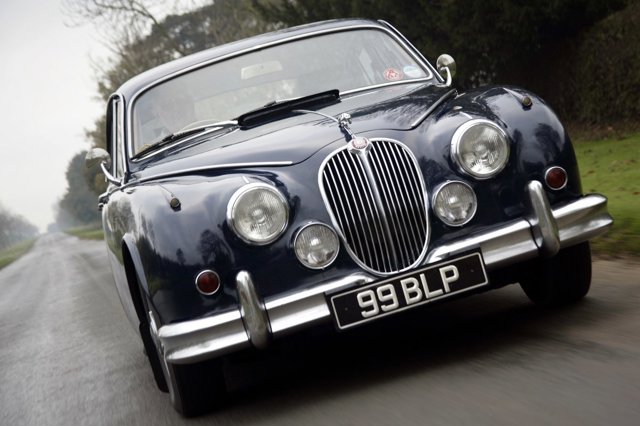June 1958
Work begins on a facelifted version of the Jaguar 2.4 and 3.4
The days of the original compact Jaguar were however numbered as in the summer of 1958 the company began to develop a revised model called Utah facelift or Utah Mk2. The aim was to improve areas such as heating and ventilation, poor driving visibility, an interior that was perceived as being old fashioned, high speed handling and modernise the exterior.
Sir William Lyons revised the styling particularly around the rear window pillars. This and other styling touches such as a new front grille transformed the look of the car at minimal cost to Jaguar. The interior was revised with a new seats, walnut dashboard and a more modern black steering wheel. Mechanically the major change was to fit a wider track rear axle, which improved high speed handling. Burman power steering was developed for the car as an optional extra. Unfortunately these revisions to Utah added some 112 to 167lb to the car’s weight.
To compensate Jaguar fitted the B-type cylinder head to the 2.4-litre, boosting power to 120bhp at 5750rpm and torque to 144 at 2000rpm. The 3.4-litre was retained in its existing form, while a new version of the XK engine was added to the mix. The 3781cc XK engine, which had first appeared in the XK150 sports car announced in 1958, was a bored out version of the 3.4 unit. With peak power of 220bhp at 5500rpm and torque of 240lb ft at 3000rpm, this twin carburettor unit provided so must extra torque that it was decided to fit a Powr-Lok limited slip differential to the Utah Mk2 as standard.
Early prototypes were simply modified Utahs. Indeed the prototype 3.8 Mk2 was registered TVC 420 and its engine was fitted as late as 4 June 1959. In July a 3.4-litre mule was fitted with experimental Lucas fuel injection. Off tools prototypes were built in August, September, and October in preparation for volume production.
October 1959
Jaguar Mk2 launched

Utah facelift nose under development
The Utah facelift was announced as the Mk2 Jaguar on 2 October 1959. From now on both the company and enthusiasts would refer to the outgoing model as the Mk1, and we will follow suit. Indeed the Mk2 would not be available until November/December 1959, so run out stocks of the Mk1, now only available in Special Equipment guise would tide the Jaguar dealers over until the new model was available.
Autocar was the first to publish a road test of a Mk2, a 3.8 manual with overdrive, the model everyone wanted to drive. Its road test, published in February 1960 was by and large positive although there was some criticism of the seats. Performance was as expected, blistering. Top speed was 125mph, 0-60mph was reached in 8.5 seconds and fuel consumption was 15.7mpg. And all this was in a car that offered refinement and space for four people.
The automatic transmission version was not tested until April 1963, again by Autocar. The three-speed box restricted top speed to 120.4mph, 0-60mph in 9.8 seconds although fuel consumption was better at 17.2mpg. The only Mk2 3.4-litre that the UK press tested was an automatic. Motor in August 1961 attained 119.9mph, 0.60mph in 11.9 seconds and fuel consumption of 16mpg, which on the face of it was little different to the automatic 3.8-litre.
So how did the 2.4 litre Mk2 perform? Well it appears that Jaguar, who prided themselves on manufacturing 100mph plus cars, declined to loan the gentlemen of the press an example to road test It was not until March 1965 that Autocar got hold of a 2.4-litre Mk2 for a used car test. Using a run in 26,000 mile manual with overdrive car, the publication managed 96.4mph and a 0-60mph time of 17.3 seconds. Apparently the factory had not been able to achieve more than 98mph. For the moment Jaguar kept a lid on this embarrassing situation, but competition both internal and external would soon cause problems.
May 1960
Jaguar bought Daimler
On 26 May 1960 it was announced Jaguar Cars, Ltd., had arranged to buy for cash the Daimler Company from the Birmingham Small Arms group.
It was intended to continue production of the current range of Daimler vehicles, but the Daimler factory at Radford, Coventry, which had more than a million square feet of floor space, would also provide the facilities needed for expanding Jaguar’s own output. Jaguar had wanted to expand and had been refused planning permission. It was now getting a large factory – the same size as Browns Lane – within a five minute journey. Events now moved fast. Having bought out Coventry rival, Daimler, another of Jaguar’s local competitors, Armstrong Siddeley announced on 9 June 1960 that it was ceasing car production. On 18 June 1960 the Jaguar Cars purchase of Daimler was formally ratified. The deal cost Jaguar £3.4 million.

Utah interior.
The plan was to transfer XK engine production to Radford to free up more space for production at Browns Lane. These expansion plans were outlined to the press on 27 October 1960. Jaguar may have inherited a fading range of cars from Daimler and intended to turn the Radford plant over to XK engine production, but not everything Daimler produced was inferior to the Browns Lane product. Only the previous year Daimler had introduced a 2548cc overhead valve V8. Using a single central camshaft operating the valves through pushrods, the engine was designed by Edward Turner who earlier in his career had designed Motorcycle engines.
Design began in October 1956 and prototype engines were running eight months later. The V8 was designed to go in two cars, the DN250 saloon and the SP250 sports car. The DN250 was cancelled in mid 1959 and the SP250 was announced in April that year followed in October by the DP250, a prototype sports saloon based on the SP250 chassis and running gear. After the Jaguar buy out the DP250 project quickly bit the dust. However Jaguar engineers found the Daimler V8 engine was a thoroughly well designed and sound unit and the idea quickly dawned on senior management that here was the opportunity to create the sports saloon Daimler had been striving for by transplanting the V8 into the Mk2 body.
By November 1960 project ZX530/112 under the leadership of Phil Weaver was underway. A Mk1 hack car received a Daimler V8 transplant and soon impressed with its better than expected performance. Soon a Mk2 was fitted with the V8 and a Borg Warner type 35 automatic transmission. The two test cars over next 16 months were used to iron out the bugs. 1960 Was a good year for the Mk2, with 17,535 produced.

Turner V8 transformed the sporting Jaguar into a effortless Daimler.
On 15 March 1961 the Jaguar E-type was announced and its looks and performance caused a sensation. The new sports car became the public image of Jaguar Cars in the 1960s, but in commercial terms the saloon range was the firms main breadwinner. In September and October 1961 Jaguar Mk2 production was restricted by a long strike at the SU Carburettors factory at Erdington in Birmingham. On 10 October it was announced that Jaguar was diversifying into commercial vehicles when it took over Guy Motors of Wolverhampton. Two days later the MkX top of the range Jaguar saloon was announced, though it would not be a big seller in its nine year production run. Even more Mk2s were built in 1961, 21,236, which was in fact the model’s peak year.
On launch the Daimler V8 was priced between the Jaguar Mk2 2.4 and 3.4-litre, suggesting that the Daimler brand was more upmarket than Jaguar, but deferred to the more sporting image of the bigger engined cars. What the Daimler buyer got was a 2.5-litre engine which produced 140bhp at 5800rpm and torque of 155lb ft at 3600rpm, superior to the 2.4-litre XK engine. This was mated to the Borg Warner type 35 three-speed automatic transmission which was shorter than the type DG and would not be fitted to the Mk2 until June 1965. So how did it compare with the manual 2.4 Mk1 and Mk2?
In fact the Daimler was streets ahead. Top speed as tested by Autocar in May 1963 was 112.3mph, 0-60mph in 13.8 seconds and fuel consumption was 17.3mpg. In fact the top speed was reached at 6800rpm, which suggest the V8 was a much freer revving unit than the XK. Autocar said: ‘The Daimler’s particular strength is therefore it’s sweet and near silent running at any engine speed.’
However the Daimler was never exported to the USA. Senior Jaguar engineers were always dismissive of the V8 engine format, arguing that it lacked the refinement of six- and 12-cylinder engines. The Edward Turner V8s, for there was also a larger 4.5-litre unit, proved them wrong, but the men at Brown Lane were to blindly plough their own expensive furrow in the pursuit of engineering excellence, culminating in the superb but thirsty and therefore sales deterring V12 of 1971.
The Mk2 was now facing increasing competition in the American market from the first generation of muscle cars with their large capacity V8 engines. Jaguar produced 12,697 Mk2/Daimlers in 1963, with the Daimler making up 19.24% of that figure. Now a threat to the smaller capacity Mk2s would emerge in the domestic market.
In September 1966, a slump in demand forced Jaguar to go on to a four day week, again suggesting that customers were not queuing up to buy their cars . In contrast Rover at Solihull was still working flat out producing the P6. Full time working at Jaguar would not be resumed until March 1967. About the same time the company introduced a number of economy measures on the Mk2 to reduce the cost of manufacture such as substituting Ambla vinyl for leather upholstery, although the measures were not widely publicised.
October 1966
Jaguar 420 launched
On 13 October 1966 Jaguar announced the 420 and 420G models. The 420G was a revised Mk 10 while the 420 was a restyled S-type with the quad headlamp look and an addition to the Jaguar range, designed to tide the company over until the delayed XJ4 came on stream. 1966 Saw Daimler/Mk2 production slump badly to 5935, as indeed did all Jaguar saloon production, at a mere 15,990.
In February 1967 the Daimler 2.5-litre V8 became available with manual transmission for export markets only.


.jpg?width=640&height=426&rmode=crop)
.jpg?width=640&height=426&rmode=crop)
.jpg?width=640&height=426&rmode=crop)
.jpg?width=640&height=426&rmode=crop)
.jpg?width=640&height=426&rmode=crop)
.jpg?width=640&height=426&rmode=crop)

 Fast, pretty and good to drive. The definitive sporting Jaguar saloon which they got right (second time). 3.4 and 3.8-litre cars still genuinely quick.
Fast, pretty and good to drive. The definitive sporting Jaguar saloon which they got right (second time). 3.4 and 3.8-litre cars still genuinely quick.
 Look for poorly restored examples, and like its predecessor, the Mk1, it's more show than go in 2.4-litre form.
Look for poorly restored examples, and like its predecessor, the Mk1, it's more show than go in 2.4-litre form.



